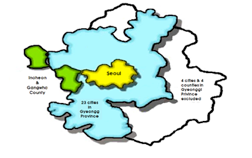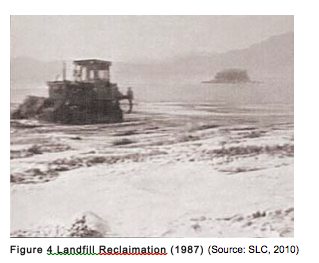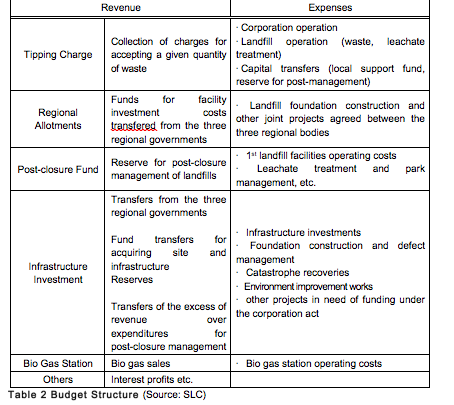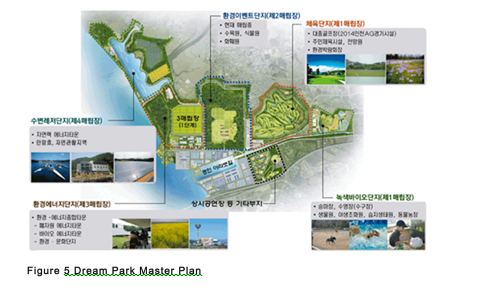Gestion intelligente des déchets à Séoul; Du déchets à des ressources - Décharges sanitaires
ISSUES
Only a while ago in the early 1960s, Seoul had no designated areas for dumping waste. Since construction materials were expensive at that time, Seoul City disposed of household garbage by selling it to private developers who used it for embankments. The amount of garbage sold by the city accounted for 57% of the total waste generated in 1971 and 40% in 1974. Meanwhile booming domestic manufacturing industry and consumption culture, emerging as a result of Korea’s rapidly growing economy, propelled a mass generation of waste on a massive scale. This is well shown in the fact that in 1977 the daily waste generation mounted to 7,000~14,000 t; waste management was becoming a critical urban issue to address.
Seoul undertook a landfill construction project to accommodate the exponentially increasing waste. From 1964 to 1977, landfills constructed in outskirts of the city including Gunja, Sangwolgok, Eungam, Yeomchang, Bangbae, Apgujeong, Jangan, Gueui, Cheongdam, Songjeong and Nanjido. (See Figure 1)

Before long, new housing developments was planned for some of the areas near these landfills. As it was no longer possible to dump waste in those regions, acquisition of large-scale landfill sites in the vicinity of Seoul became a pressing urban issue. Against this backdrop, Nanjido was chosen as the site for a new landfill for its convenient location. It was subsequently designated as ‘Waste management Facility’ by the Seoul Metropolitan Government in August 1977.
Records tell us Nanjido Landfill was officially put into operation in March 1977. In general the planning for a landfill should be carried out through a certain process: identification of suitable areas, detailed site investigation, capacity and cost evaluation, comparison of candidates, and final site selection. Due to the urgent nature of the project, however, the construction of Nanjido Landfill had to be completed without the due process procedures. As Seoul’s major landfill site, Nanjido Landfill took care of 78% of the total waste produced in Seoul from 1978 to 1992.
.png)
Waste management practice in Seoul during the 1980~90s was heavily reliant on landfills, dealing with the average daily waste generation of 30,000t. Because of its limited space, Nanjido Landfill was originally planned to have capacity of 45m and to operate for a period of 6 years. The plan to convert the site to agricultural use once the landfill is closed and capped after six years of operation, however, had to be modified with the delay in the construction of Sudokwon Landfill. Operation of Nanjido Landfill thus continued until the late 1992 after 15 years since its opening, accepting 78% of Seoul’s household waste.
Since garbage was piling up in Nanjido Landfill as running out of capacity, a 89 meter high soil wall was constructed along the landfill by recycling construction materials and briquette ashes to add extra capacity in 1985. When Nanjido Landfill finally had a well-overdue closure with 92 million ㎥ of trash, there was a massive pile of garbage, 92~94 meters in height, in the first site and another with a height of 97~99 meters in the second site. As the exhaustion of Nanjido Landfill raised citizen’s worries about its impact on the environment and health, securing a new landfill site became an urgent urban issue.

SOLUTIONS
Pressed with an explosion in waste generation in the late ‘80s and the limited capacity of the landfill in Nanjido, Seoul had to secure an additional site for waste facilities. Under this circumstance, construction of large-scale landfill was promoted on a reclaimed land of 20 million ㎡ located 40 minutes from Seoul. After establishing plan for securing the site in 1987, the construction began when the agreement on the construction and operation of the new landfill was signed in 1989 between the Ministry of Environment and the regional bodies involved. Sudokwon Landfill, the world’s largest sanitary landfill, has processed waste from Seoul and its vicinity with a population of 24 million people since February 10, 1992. As of May 2013, daily average waste of 13,400 tons from households, construction sites, and businesses goes to Sudokwon Landfill. Employing sanitary landfill method, it is expected to accommodate 228 million tons of waste in total. 44.5% of the total municipal waste intake comes from Seoul metropolitan area; 16.5% comes from Incheon Metropolitan area and 39% from Gyeonggi-do. The landfill area is divided into 4 sites: the first site closed in 2000, and the second site is in use.
2.1. Planning
1) Site Selection
To accommodate an explosion in urban population and waste generation, the government established a long-term plan for the construction of new landfills. After Seoul Metropolitan Government and Gyeonggi Provincial Government nominated twelve candidate sites in Gyeonggi-do, the results of feasibility studies revealed that none of the reviewed sites was suitable because an infinite sum of money would be required for purchasing the land and compensating for private properties and the small area available. The available land area in Gyeonggi-do was also simply too small, and the prospect of a drastic increase in traffic drew objection. Furthermore, negative implications of separate dumping around Seoul for the environment and sanitation in the whole Seoul metropolitan area provoked opposition. After the Ministry of Environment taking over the project who reviewed seven candidate sites to be reclaimed, Gimpo district was chosen for its convenient location. Despite the inconvenience in leachate management and moving waste, locating a new landfill by reclaiming from the sea would save money for purchasing land and also facilitate more efficient use of land. Thereupon embankment construction for the new landfill site was completed in February 18 1987.
2) Plan for Sudokown Landfill Construction
After Gimpo was chosen for the new landfill site, the Ministry of Environment and Dong Ah Construction signed a MOU in 1988. According to the agreements made among Seoul, Incheon and Gyeonggi-do in a meeting to discuss the new landfill construction, the central government is liable to finance the construction of the landfill and the road infrastructure was to be financed by the involved regional governments. Following the agreement, ‘Plan for Sudokown Landfill Construction’ was established in April 1987.
2.2. Implementation
Several organizational changes have been made to eliminate overlap and confusion among different parties engaging in the planning, construction and management process of Sudokown Landfill.
1) Coordination Committee for Sudokown Shore Landfill (1984)
Following the agreements regarding the construction, operation and management of the new landfill in Gimpo among the Ministry of Environment and the involved municipal governments (Seoul, Incheon, Gyeonggi-do), Coordination Committee for Sudokown Shore Landfill was inaugurated. Its main duty is to enhance coordination among different municipal bodies. The committee decides such issues as how much each regional government should pay for the construction of the landfill and supporting infrastructure, organizing a consolidated body for the management of the new landfill and other major issues related to the landfill management.
2) Sudokown Landfill O&M Union (1991)
To improve the management of the completed landfill sites, restructuring of organizations was suggested. With Environmental Management Corporation taking over the affairs related to the already completed landfills, Sudokown Landfill O&M Union was launched for joint management and operation of Sudokown Landfill Site in November 11 1991.
3) Sudokwon Landfill Site Management Corporation (SLC)
Under ‘Law on the Establishment and Operation of Sudokwon Landfill Site Management Corporation’ legislated in July 2000, SLC launched as a national body affiliated with the Ministry of Environment. Before the establishment of a consolidated body to streamline the fragmented management of the landfill site, conflicts and confusion arose between different regional bodies over the roles and responsibilities. Having integrated its predecessors, SLC is composed of three head offices, seven agencies, and two offices and run by 168 staffs. Upon its inauguration in July 22, 2000, SLC arranged an operation committee consisting of local residents, environment experts and public officials. Also established was Sudokwon Resident Council, the official community support entity. Major issues on the management of SLC are under the operation committee’s supervision before being passed on to the board of directors of SLC. Community support affairs are to be discussed through consultation with Sudokwon Resident Council. As for the issues related to the landfill construction, decisions are to be made by the Ministry of Environment, Seoul Metropolitan Government, Incheon Metropolitan Government and SLC.
2.3. Fiscal Structure
1) Securing Land and Funding for Landfill
The site in Gimpo was originally a wetland reclaimed by Dong-ah Construction Ind. for agricultural use. The Ministry of Environment acquired the site at 52.3 billion won including 45 billion won for land purchase, 67 billion won for the loan interest payments and 0.6 billion for the bank commission.
Cost share arrangements between the involved regional governments for the construction were made by Coordination Committee for Sudokown Shore Landfill at a ratio of 100:16:16 (Seoul:Incheon: Gyeonggi-do). Each region’s share for reclaiming the site was apportioned on the basis of population of 1998. In detail, expenses made by Seoul Metropolitan Government included 27.3 billion won for acquiring the land, 25.6 billion for the first landfill construction, 24 billion for the installation of other facilities, and 25.2 billion for the second landfill.
2) Revenue
Majority of SLC’s revenues comes from the charge levied upon the waste received. Since 2007, revenues from charge collection have been on the decline due to the changes in government’s policies including strengthened regulations on inflammable waste intake, technological improvements in local incineration plant. However, with increased funding from regional governments for eco-tourism and community facilities and the third landfill site and increased CNG sales, the SLC’s short-term and mid-term growth prospects are positive.
3) Expenditures
The expenses portion of the budget accounts for costs associated with facility investments, construction and post-closure management, the community fund and operation of SLC and biogas stations, etc. Transfers of the excess of revenue over expenditures are saved for post-closure management. Together with increasing sales of Sudokwon Landfill Site, expenses are also expected to increase until 2017 as the city is preparing for the third landfill and environmental energy town project.

2.4. Challenges
1) Local Resistance
When Sudokwon Landfill Site was being built, residents’ resistance was not as strong because the region had much less population back then. Soon, however, the area within five kilometers from the site would see an outburst in population, which exacerbated conflicts between residents and authorities; as of 2013, there are 200,000 residents in a town which had only 20,000 residents in 1980s. The residents became more aware of environmental impacts of the nearby manufacturing factories; concerns grew over possible degradation of their living environment from facilities for sludge and leachate treatment and gas generation, etc.
Various measures were taken to address the controversy derived from misunderstanding and distrust. To gather the residents’ opinions and complaints, the authorities arranged Sudokwon Landfill Site Operation Cooperative and discussed affairs related to the construction and operation of landfill and community support projects. Residents were encouraged to take part in site inspections and resident monitoring program. Later, upon the inauguration of SLC, an operation committee was established consisting of community representatives to collect the residents’ opinions and provide them supports where they are needed. In addition, a community support fund was formed to prepare funding for improving the living environment and quality of life in the areas of influence. All of these approaches seek to minimize the landfill’s negative impact on public health and community environment and harmonize with the residents.
2) Conflicts between Regions over Landfill Extension
As the government has consistently reduced the amount of trash it generates and improved waste management methods, the share of landfill had a substantial decrease. This, however, created conflicts over extending the life of Sudokown landfill between Seoul and Incheon city government. Seoul, with the support of the Ministry of Environment, insisted on continuing the operation of Sudokwon Landfill Site until 2044. Incheon’s city government, on the other hand, wanted it to stop taking trash by 2016 as originally planned. The government was initially favorable to Seoul and pursued the construction of the third landfill to the existing landfill site, but has changed its stance due to the public outcry from Incheon citizens. (Lee et al. 2013).
Successful management of conflicts between different entities depends on mutual understanding built through negotiations. Extension of the existing facilities can minimize local resistance when adequate strategies are in place. While the government is trying to reduce reliance on landfill, SLC has successfully provided residents with a greener waste management service so far.
Results
3.1. Output
1) Acquisition of World’s Largest Sanitary Landfill
Sudokwon Landfill Site is the world largest landfill site built on 20 million square meters of land. With its environmentally friendly management with advanced waste management technologies, the adversive effect derived from landfilling has been greatly reduced; it has created a more pleasant living environment for local residents. As a consequence of the relentless efforts to sophisticate leachate and waste treatment techniques, accomplishments of Sudokwon Landfill Site have been recognized worldwide
2) Profit Generation through Resource Recovery
With the ongoing investments for developing high-tech land filling technologies, as much efforts are being made to make waste management more environmentally friendly through waste-to-energy initiatives. Methane gas from the buried garbage is utilized as a source of energy, is sent to the turbine to power the landfill site. Surplus methane gas is treated by the central incinerator to prevent greenhouse gas emissions. All together, SLC is expecting a substantial profit by reducing 1.21 million tons of CO2 per year and also from sales of carbon credits.
3) Dream Park
The closed first landfill has been successfully rehabilitated into the biggest eco-friendly park in Korea.
This massive public amenity features wildlife preservations and arboretums and also offers a hands-on learning ground for its visitors. Dream Park, which took four years to build, was promoted as part of SLC's environmental project designed to restore nature in the site. The park has already established itself as a popular tourists’ attraction.

3.2. Outcome
1) Laying the Groundwork for Waste Management Policy
Since its operation, the foul smell, dusts, harmful insects and toxic leachate from the landfill has gathered many complaints from residents. As a countermeasure, the landfill decided to cut its nighttime operations. The decision faced opposition from regional governments and cleaning companies. However, after community consultation process it gained more acceptance and was finally put in full-fledged action in May 2000. As a result, the safety risks and issues related to working 24-hours were hugely improved along with unauthorized nighttime dumping problems.
Effective waste management depends upon achieving greater mutual understanding amongst stakeholders. When an organization becomes fragmented, it requires more work to deliver support to the residents and to respond to local needs. SLC’s communication platform for residents is streamlined to facilitate execution of community support projects and foster cooperation with the community. On the other hand, since the establishment of community support fund, residents are allowed to engage directly in planning for community improvement projects.
2) Engaging Residents in Landfill Management
Dealing with community resistance has never been an easy task, however, SLC has made outstanding progress by providing relentless community support and communicating with local residents. Community monitoring agents work on behalf of the community to act as a watchdog and ensure a fair waste management practice. Launching Sudokwon Landfill Site Residents’ Supporting Council, SLC actively seeks civic participation in community briefings to communicate the waste policies between the community and involved authorities.
As the residents are allowed to directly engage in the landfill’s management, their ideas and opinions on major issues are reflected in the decision-making process, such as relocation of residents in the area of direct influence and prevention of illegal waste intakes. Besides, SLC holds a variety of projects designed to enhance the quality of life in the community.
Lessons Learned
1) Landfill Rehabilitation to Turn to a Park
Alongside a well-maintained sanitary landfill, expired landfill has been reclaimed for an environmental theme park, 36 hole-golf course, soccer fields and tennis courts. Environmental energy town will be powered by renewable energy and waste-to-energy technologies. Adjacent to other local development such as Incheon International Airport and Gyeongin Ara Waterway, the park is assisting the local economy by attracting tourists.
2) Sustainable Energy Project under CDM
Sudokwon Landfill Gas Electricity Generation Project (50 MW) is registered as a Clean Development Mechanism (CDM) project defined in the Kyoto protocol. It aims at achieving a LFG collection rate of 75% and power generation of 50W at Sudokwon landfill area. It is expected to earn saleable certified emission reduction (CER) credits, which may be traded in emissions trading schemes. CDM projects are expected to assist developing countries in achieving sustainable development. It has to be taken into accounts, however, that successful implementation of CDM projects requires an approved baseline and adequate monitoring methodology, not to mention advanced technologies and experiences.
3) Tackle Organizational Fragmentation with Establishment of Consolidate Body
Sudokwon Landfill Site was initially operated and managed by Sudokwon Landfill Site Operation Cooperative made up of staffs from the three sharing regional governments. However, the fragmented organizational structure led to poor accountability, disrupted project flows, and low administration efficiency. In July, 2000 under the Ministry of Environment SLC was established as a federal venture to streamline the management. Its inauguration has made an impact on the efficiency of the management and operation of the landfills, making SLC's case a good role model in the waste management sector.
Department / Contact
- International Relations Division / 82-2-2133-5376 / international@seoul.go.kr
- Megacity Research Center / 82-2-2149-1418 / simrc@si.re.kr